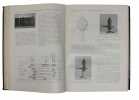"HESS, V. F.
Uber Beobachtungen der durchdringenden Strahlung bei sieben Freiballonfahrten. - [THE DISCOVERY OF COSMIC RAYS]
Leipzig, S. Hirzel, 1912. Royal8vo. Bound in two contemporary half cloth with white paper title label to spine. In ""Physikalische Zeitschrift"" Vol. 13, 1912. Library stamp to title pages. Otherwise fine and clean. Pp. 1084-91. [Entire volume 1: XXV, (1), 576 pp + XXII plates"" Pp. 577-1228 + XXXV plates.
Reference : 46932
First printing of Hess's paper in which the discovery of cosmic rays first was introduced. He was awarded the Nobel Prize in Physics in 1936.At the start of the 1900's, French physicist Henri Becquerel discovered that certain elements are unstable, and would transmute into other elements, and in the process, emit what appeared to be particles. These ""particles"" were given the name ""radiation"", and the process itself referred to as ""radioactive decay.""To study the source of this background, Austrian physicist Victor. F. Hess made measurements of radiation levels at different altitudes with electroscopes aboard a balloon. The motivation for this study was to distance the electroscopes from radiation sources in the Earth. Hess went as high as 17,500 feet in his balloon without oxygen tanks. Surprisingly, he found that the radiation levels increased with altitude. Hess interpreted this result to mean that radiation is entering the atmosphere from outer space. He gave this phenomenon the name ""Cosmic Radiation"", which later evolved to ""Cosmic Rays"". Hess was awarded the Nobel Prize in 1936 for his discovery of cosmic rays""""Hess took up the problem stated by Wulf in 1911. He first verified the rate of absorption of gamma rays and then, with the help of the Austrian Academy of Sciences and the Austrian Aeroclub, made ten difficult and daring balloon ascensions, collecting data with improved instrumentation. He reached a height of 5,350 meters, with striking results. He was able to establish that to a height of approximately 150 meters above sea level, radiation decreased according to known laws, while at greater heights radiation increased steadily, following approximately the same laws. He found radiation at 5,000 meters to be several times greater than that at sea level, and also that radiation at all levels was the same night or day, and therefore not the result of the direct rays of the sun. He was thus able to conclude that the radiation he recorded at high altitudes entered the atmosphere from above and was, in fact, of cosmic origin. His results were verified in an extension of his experiments made by W. Kohlhörster in1913-Kohlhörster reached a height of 9,300 meters, and recorded radiation of twelve times that at sea level-but were not acknowledged by other physicists for a number of years. (""Cosmic rays"" were so named by R. A. Millikan in 1925.) In 1913 Hess himself equipped the meteorological station on Hoch Obir (2,141 meters) in Carinthia to accommodate further studies of cosmic radiation" these experiments, however, were brought to a halt by World War I.University, and the University of Innsbruck the Ernst Abbe prize of the Carl Zeiss Foundation (1932)" and the Austrian Medal for Science and Arts (1959). The most important honor, however, was the Nobel Prize in physics, which he shared with C.D. Anderson in 1936, on which occasion he lectured on ""Unsolved Problems in Physics: Tasks for the Immediate Future in Cosmic Ray Studies."" The discovery of cosmic radiation was one of the keys to the study of elementary particles in general, leading to the discovery of the positron, by Anderson in 1932, and of the ? meson by F. Neddermayer (in 1937)."" (DSB)
Bookseller's contact details
Herman H. J. Lynge & Son
William Schneider
Silkegade 11
1113 Copenhagen
Denmark
+45 33 155 335
Payment mode
Sale conditions
All items may be returned for a full refund for any reason within 14 days of receipt.
 Write to the booksellers
Write to the booksellers








